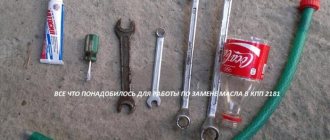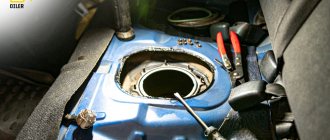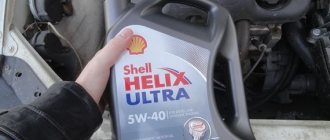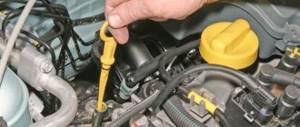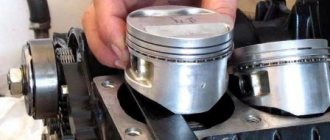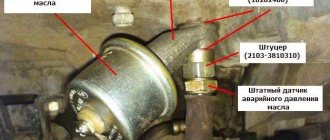Why does the oil burn out and the level on the dipstick stays the same?
Burnt oil can be easily determined. If blue smoke is visible from the exhaust pipe, it means the oil is burning. If the dipstick shows that the oil is at a normal level, then you should do a couple more checks. To check the oil level in a car you need to:
- take out the dipstick;
- wipe the dipstick with a rag;
- push the dipstick back all the way;
- take it out and check the level.
If, after several checks, the dipstick shows that the oil level is normal, then there are several options:
- The limiter “walks” near the probe.
- Gasoline gets into the engine.
Malfunction of injectors and piston group
To determine injector malfunctions, the car owner must connect a pressure gauge and check the pressure in the power system. Having determined the upper limit of values, it is necessary to additionally monitor how the instrument readings change. Usually, when the pressure gauge needle moves downward, this indicates that fuel is coming out through faulty injectors. Well, to visually understand which injector is faulty, simply start the engine and, after it has reached the optimal pressure in the power system, immediately turn off the ignition. A faulty injector in this case will roughly spray fuel. But the most expensive and difficult repairs will be in case of malfunctions of the piston group. And here the problem mainly arises due to the use of low-quality fuel and oil. Because of this, coking processes occur on the piston rings and as a result, the fuel simply evaporates through the resulting gaps. To determine such a problem, you will need a compression gauge.
You can learn more about this in this interesting video:
Published: September 24, 2020
How to tell if there is fuel in the oil
Here are the main signs that gasoline is getting into the oil:
- The unit significantly loses its power and fuel consumption increases.
- The exhaust has a bluish color and a burning smell.
- Engine malfunctions occur.
- The engine starts to stall, stall, and the speed fluctuates.
- The engine began to run noisily and knock.
- The oil level is high because gasoline is mixed with it.
You can check whether there is gasoline in the oil using an oil dipstick and a sheet of paper. You just need to drop one drop of oil onto a piece of paper and then dry it. If the edges of the spot remain smooth, then there is no gasoline in the oil.
In addition to gasoline, antifreeze can get into the oil, and an emulsion is formed. Driving with such a mixture can cause engine water hammer.
The essence of the problem
In a normally running car engine, the fuel system is isolated from the lubrication system, which carries oil. Gasoline, in principle, should not get into the oil. But if this happens, then it is natural that when checking the oil level, the dipstick will emit the smell of gasoline.
Internal combustion engines.
If you don’t trust your sense of smell, you can very easily check the presence of gasoline on the oil dipstick. It is enough to move away from the car and bring a lit match to the dipstick. Clean oil does not light up quickly, but the presence of gasoline will appear with a bright flash.
There are a number of known factors that indirectly indicate gasoline leakage from the fuel system: an increase in gasoline consumption compared to previous operation; a decrease in engine power, which is noticeable when starting from a stop or climbing an incline; change in oil color and odor; the appearance of a strange noise in the piston block.
The presence of fuel in the oil clearly indicates a malfunction. The main reasons for this phenomenon are a malfunction of the fuel pump, damage to the injector on an injection-type engine, and disturbances in the piston system.
Why does gasoline get into the oil?
There are main reasons why gasoline can get into the oil, here they are:
- if there is a significant over-enrichment of the fuel mixture;
- there is a malfunction in the fuel pump or injectors. Often the membrane in the fuel pump breaks and thus gasoline enters the engine;
- the ignition system does not work correctly;
- engine wear. The fuel does not ignite, there is no necessary compression.
If it is noticed that gasoline gets into the oil, then you should not operate the car until the problem is eliminated.
Gasoline in engine oil, causes of malfunction
The engine oil on the dipstick smells like gasoline - a sure sign that it has entered the engine sump and mixed with the oil.
This malfunction occurs on both carburetor and injection engines. It leads to dilution of the engine oil, loss of its lubricating properties and, as a result, a decrease in the service life of the rubbing parts of the car engine. In the most advanced cases, call for an immediate overhaul of the engine.
How can you tell if gasoline is getting into the engine sump?
The best, easiest and safest way is to smell the oil on the dipstick after parking the car. It should smell like motor oil. If there is gasoline in it, its smell will cover the smell of oil.
Causes of malfunction: gasoline in engine oil
Faulty fuel pump (carburetor engine)
The most common reason for gasoline getting into the engine oil is damage to the diaphragm of the mechanical fuel pump. The appearance of cracks and abrasions on the diaphragm, as a result of fatigue wear or due to poor quality of the part, allows gasoline from the fuel pump body, in a sufficiently large volume, to flow through the body of the auxiliary units and the cylinder head into the engine sump. In some cases, this situation leads to an increase in the oil level in the pan due to gasoline admixtures.
In addition to a faulty diaphragm, such a problem can be caused by loosening of the diaphragm on the axle (gasoline flows down it when the diaphragm is working properly), or incorrect assembly of the fuel pump during its repair.
Additional signs: a persistent smell of gasoline appears in the engine compartment and/or interior of the car; fuel leaks appear on the fuel pump housing.
Diaphragms for DAAZ fuel pumps for VAZ 2108, 2109, 21099 cars
Faulty injectors (injection engine)
If the seal of the injectors is broken (internal deposits, clogging), fuel will ooze from its nozzles while the car is parked, squeezed out by the pressure in the fuel rail. Depending on the degree of loss of tightness of the injectors, more or less gasoline will escape.
Engine piston group is faulty
Increased clearances in the piston group of a car engine allow the fuel mixture to enter the engine sump.
Ignition system components are faulty
For example, faulty spark plugs, high-voltage wires, incorrectly set ignition timing, etc., lead to misfire in the engine cylinders or untimely injection. The injected fuel does not burn or does not burn efficiently. It flows along the cylinder walls into the engine sump.
What to do if gasoline is found in the engine oil?
First of all, it is necessary to establish the cause of gasoline getting into the engine oil and eliminate it. On a carburetor engine, replace the fuel pump diaphragm and check its attachment to the rod. On the injection unit, check the injectors for leaks and rinse or replace them. If the engine piston group (pistons, rings, cylinders) is worn out, it will have to be overhauled. A piston malfunction can be determined by measuring the compression. In addition, we check the elements of the ignition system.
After eliminating the malfunction, you will have to replace the engine oil with new one.
Notes and additions
Malfunctions leading to the appearance of gasoline in the engine oil are usually accompanied by a violation of engine starting, unstable idle speed, dips and jerks in operation, a decrease in power and throttle response, and an increase in fuel appetite.
More articles on car engine malfunctions
Why does the muffler exhaust pipe turn black? Burnt-out valve signs and causes of malfunction No gasoline supply to the car engine High fuel consumption by an injection engine, causes Low engine oil pressure in the car engine, causes of malfunction
Do I need to change the oil?
Why does oil get into the air filter, the main reasons, what to do, how to avoid the problem Why does oil get into the air filter and what to do
Gasoline got into the oil, and now you stand and think: “What should I do now?” The desire to save money immediately projects in our brains the stories of “experienced people” about how 50 years ago they poured a glass of gasoline into the crankcase of their Moskvich or Volga in order to easily start the car after a frosty night. Then the left hemisphere is connected, and we remember the engine lubrication scheme, its temperature, and the boiling point of gasoline (somewhere around 90C).
And here greed and stinginess completely “covers us” and we make an irreparable mistake, of course, if we have a car of a class higher than Moskvich, Zaporozhets or a kopeck. And that's why:
Let's deal with the first myth from the old people. Yes, the method of 200 grams of gasoline into oil is quite possible, or rather it was, at that time there were two types in the range of lubricating oils: 1 what was in the store; 2 what they managed to steal from the enterprise.
Moreover, in both the first and second cases, it is not at all necessary that the season coincide with the viscosity of the oil that was managed to be obtained.
Secondly, let us remember the accuracy of fitting of the liners, connecting rods, and rings. It’s probably not worth explaining that the manufacturing class then and now are significantly different. And parts of “old” car brands were not so picky about the quality of lubricant.
Now let’s dispel or confirm the myth about gasoline boiling. Of course, it will boil away over time when the engine and oil temperatures reach above 90 degrees. But for this we need time, because the engine does not warm up instantly, and in winter, with good frosts, sometimes the engine may not warm up even after 20 km. And here there are two ways for the development of the event: 1 the oil pump will still “grab” gasoline instead of oil, because oil is heavier than gasoline at what level the separation of two oil products of different densities occurred is unknown; 2 the oil pump will always pump oil.
Therefore, for those who want to save money, we suggest telling fortunes using coffee grounds what exactly the gas pump will pump gasoline or oil? In addition, when gasoline boils, vapors enter the corrugation through the crankcase ventilation pipe, which supplies air to the throttle valve, and this is where they settle, and after a while the throttle valve will require a Charcot shower to remove carbon deposits.
Now we can sum it up.
If a significant amount of gasoline has entered the engine, so that it can be determined by the dipstick, change the oil, but it is advisable not to go anywhere, but to carry out an oil change operation on the spot.
If a small amount of gasoline gets into the oil (the starter was idled several times) and the oil level has not increased and a slight smell of gasoline is coming from the filler hole, you can not change the oil, but it is advisable to warm up the car to 90 degrees before driving.
Tips and tricks
As a rule, in the event of a problem, it can be quite difficult to quickly determine why the exhaust pipe smells of gasoline, the smell of gasoline is detected when the windows are open, the smell of evaporating fuel is heard under the hood, in the cabin, etc. without proper experience. For this reason, it is optimal to deliver the car to a service station and show it to specialists who will inspect and perform computer diagnostics of the engine and its systems.
We also note that the situation when the smell of gasoline appears in the engine oil should deserve special attention. If the oil smells like gasoline, or you can hear a distinct smell of fuel coming from the oil filler neck, then the situation is serious. The cause is again incomplete combustion of the fuel, with unburned residues entering the lubrication system.
The greatest danger is that the presence of fuel in the oil indicates a decrease in the viscosity of the lubricant and loss of other beneficial properties. As a result, the wear of the engine, its loaded parts and components significantly increases.
Most often, the most intense penetration of fuel into the oil occurs on a cold engine, since after warming up the fuel evaporates better and flows less intensively into the crankcase. In any case, the problem needs to be solved as soon as possible, since operating the engine with a gasoline-oil mixture in the lubrication system is highly not recommended.
